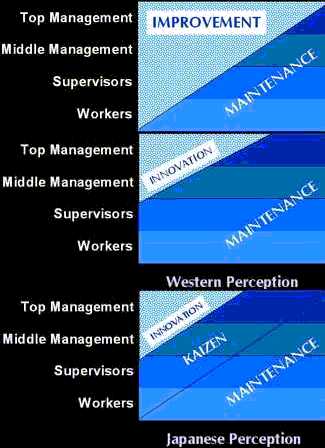


 |

|

|
|
GOLF |
|
||
Kaizen , Japanese for "improvement" or "change for the best", refers to philosophy or practices that focus upon continuous improvement of processes in manufacturing, engineering, and business management. It has been applied in healthcare,[1] psychotherapy,[2] life-coaching, government, banking, and other industries. When used in the business sense and applied to the workplace, kaizen refers to activities that continually improve all functions, and involves all employees from the CEO to the assembly line workers. It also applies to processes, such as purchasing and logistics, that cross organizational boundaries into the supply chain.[3] By improving standardized activities and processes, kaizen aims to eliminate waste (see lean manufacturing). Kaizen was first implemented in several Japanese businesses after the Second World War, influenced in part by American business and quality management teachers who visited the country. It has since spread throughout the world[4] and is now being implemented in environments outside of business and productivity.

The Sino-Japanese word "kaizen" simply means "good change", with no inherent meaning of either "continuous" or "philosophy" in Japanese dictionaries or in everyday use. The word refers to any improvement, one-time or continuous, large or small, in the same sense as the English word "improvement".[5] However, given the common practice in Japan of labeling industrial or business improvement techniques with the word "kaizen" (for lack of a specific Japanese word meaning "continuous improvement" or "philosophy of improvement"), especially in the case of oft-emulated practices spearheaded by Toyota, the word Kaizen in English is typically applied to measures for implementing continuous improvement, or even taken to mean a "Japanese philosophy" thereof. The discussion below focuses on such interpretations of the word, as frequently used in the context of modern management discussions.
Kaizen is a daily process, the purpose of which goes beyond simple productivity improvement. It is also a process that, when done correctly, humanizes the workplace, eliminates overly hard work ("muri"), and teaches people how to perform experiments on their work using the scientific method and how to learn to spot and eliminate waste in business processes. In all, the process suggests a humanized approach to workers and to increasing productivity: "The idea is to nurture the company's human resources as much as it is to praise and encourage participation in kaizen activities."[6] Successful implementation requires "the participation of workers in the improvement."[7] People at all levels of an organization participate in kaizen, from the CEO down to janitorial staff, as well as external stakeholders when applicable. The format for kaizen can be individual, suggestion system, small group, or large group. At Toyota, it is usually a local improvement within a workstation or local area and involves a small group in improving their own work environment and productivity. This group is often guided through the kaizen process by a line supervisor; sometimes this is the line supervisor's key role. Kaizen on a broad, cross-departmental scale in companies, generates total quality management, and frees human efforts through improving productivity using machines and computing power.[citation needed]
While kaizen (at Toyota) usually delivers small improvements, the culture of continual aligned small improvements and standardization yields large results in the form of compound productivity improvement. This philosophy differs from the "command and control" improvement programs of the mid-twentieth century. Kaizen methodology includes making changes and monitoring results, then adjusting. Large-scale pre-planning and extensive project scheduling are replaced by smaller experiments, which can be rapidly adapted as new improvements are suggested.
In modern usage, it is designed to address a particular issue over the course of a week and is referred to as a "kaizen blitz" or "kaizen event".[8] These are limited in scope, and issues that arise from them are typically used in later blitzes.
